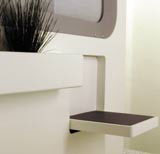Class distinction
Interiors of aeroplanes, trains and hotels are all drawing inspiration from each other, and always with an emphasis on luxury. Trish Lorenz checks in with style

Talbot acknowledges this was achieved in some parts of the train more effectively than others, and cites the entrance zone and bar area as good examples.
In the carriage entrance the group focused on lighting. When doors open a lamp slowly casts a pool of light on to the carpet, creating a warm glow. Throughout the cabin a series of LED downlights and sidelights, ‘rather than a baleful and icy centre strip’, create a sophisticated mood, creating an ambience that is similar to that which the best contemporary hotels achieve, says Talbot.
The bar area uses a lot of glass – in a style that is reminiscent of contemporary coffee shop decor – and the colour palette is also ‘close to contemporary interiors’, he says, with neutral, warm colours and matt rather than gloss finishes.
But if transport designers are looking to bricks and mortar for inspiration, interior designers are also stealing their ideas.
Yotel!, Simon Woodroffe’s latest venture, blatantly plunders from airline schemes. Woodroffe says even the idea for his enterprise – a chain of luxury, affordably priced capsule hotels – came to him in the air.
‘I was lucky enough to be upgraded and was lying in a first-class British Airways bed,’ he says. ‘And I just thought, “This is real luxury, wouldn’t it be great to offer this in a hotel”.’
Priestman Goode created interiors for the space, and director Nigel Goode is candid about the source of his team’s inspiration.
‘We came from our aircraft experience in designing the space,’ he admits. ‘In an aircraft you look for quality from a small space and we’ve used that as the basis for to how to make the hotel environment more luxurious.’
In a Yotel! room, versatile objects make the best use of a limited amount of space. The bed rotates and slides under a panelled wall to become a sofa, much in the way an aircraft seat moves from a sitting to sleeping position. A tabletop hangs flush to the wall and folds out for use; it’s a larger, more luxurious version of an on-board tray table.
‘One of the issues in a small environment is that everything is close up,’ explains Goode. ‘In a small space you need to focus on the quality of detailing and be more consistent. You need a common theme.’
This was achieved in Yotel! interiors, just as it was on-board a plane, by commissioning a bespoke solution.
‘Everything is designed specifically for the environment. Nothing jars, there’s a consistent design language,’ says Goode. ‘We’ve distilled it back to the key basics. Airlines offer a good seat, food, entertainment and a good bed. It’s the same at Yotel!.’
The trend for a crossover between transport and interior design looks set to continue. British Airways is employing the services of interiors queen Kelly Hoppen and London Transport has found a lucrative niche selling branded items for home interiors use (DW 28 October).
So if you wake up in a strange bed and can’t recall if you’re in London, New York or Moscow, bear in mind that you might just be cruising at 30 000 feet somewhere between all three.
-
Post a comment




